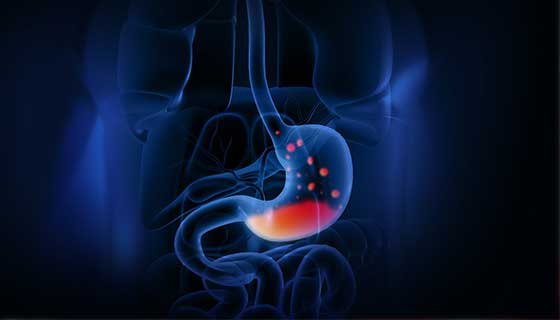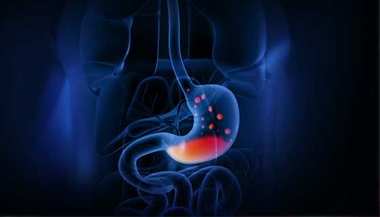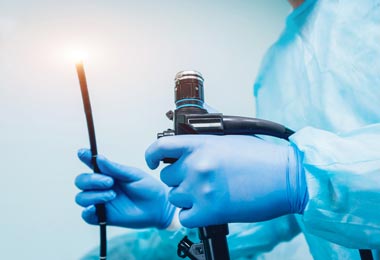Peroral Cholangioscopy
Peroral cholangioscopy uses an endoscope (a flexible tube with a camera) to examine and treat problems in the biliary system (organs and tracts that make and move bile).
What You Need to Know
- Peroral cholangioscopy helps diagnose and treat problems in the biliary system, such as blockages and infections.
- “Peroral” means the access to the biliary tract is gained through the mouth. Another type of cholangioscopy, called percutaneous cholangioscopy, requires cutting through the skin.
- Peroral cholangioscopy is a minimally invasive, outpatient procedure. Patients usually go home the same day.
What is peroral cholangioscopy?
Peroral cholangioscopy is a type of cholangioscopy, which is a procedure to examine and treat problems inside the biliary tract — branchlike passageways that allow the flow of bile and other fluids among the gallbladder, liver, pancreas and small intestine as part of the digestive process.
Cholangioscopy can be used to identify and address blockages in biliary, liver and pancreatic ducts, such as large, difficult-to-remove bile stones, gallstones and pancreatic duct stones. The technique can also be used to spot cancers in the ducts and to collect tissue samples (biopsies).
There are several types of cholangioscopy. Peroral cholangioscopy, which uses an endoscope inserted through the mouth, is the most common type.
Who may need cholangioscopy?
Your gastroenterologist may recommend cholangioscopy if you have signs or symptoms of a blocked duct, or a stricture — a narrowed duct.
Cholangioscopy can help diagnose and address problems such as:
- Biliary or pancreatic duct stones. To address a duct blocked by a bile stone, the endoscopist can use special tools with the endoscope. For instance, laser beams or sound waves can be directed to break a bile stone into small pieces (lithotripsy), or water can be streamed under gentle pressure to flush the stone out of the duct.
- Bile duct blockage or infection (cholangitis). Cholangioscopy can locate the underlying cause of this problem, such as bile duct stones, tumor, or fungal or parasitic infection.
- Duct strictures, including primary sclerosing cholangitis. Endoscope tools can widen the opening of a narrowed bile duct to enable proper flow of bile or to place a stent — a thin, hollow tube inserted into a duct to hold it open.
- Bile duct cancer (cholangiocarcinoma). Because cholangioscopy helps see details of potentially malignant spots, including blood supply, it can help precisely locate cancer and collect a better specimen to send to a pathologist (biopsy). The technique can also assist doctors in removing tumors or treating cancerous areas with argon laser or phototherapy.
- Pancreatitis caused by bile stones.
Also, your doctor may recommend cholangioscopy if an X-ray does not provide a clear enough picture of the ducts, or if a biopsy of a suspicious spot is needed to diagnose or rule out cancer.
Types of Peroral Cholangioscopy
Peroral cholangioscopies are most commonly performed as single-operator cholangioscopy — a newer technique that uses an ultra slim endoscope. Single-operator procedures are called direct peroral cholangioscopy (DPOC) and can be helpful in removing even large or complex stones from a duct. Also, these devices’ fine fiber optics can enter and examine even very small ducts.
The New Era of Digital Cholangioscopy
Related Procedures
Your doctor may recommend different or additional tests to help visualize the biliary tract:
- Peroral pancreatoscopy (POPS) is an endoscopic procedure to visualize the pancreatic duct with fiber optics. It is effective in spotting certain forms of cancer.
- Endoscopic retrograde cholangiopancreatography (ERCP) is a test to identify and address problems in the liver, gallbladder, bile ducts and pancreas by using a combination of endoscopic techniques and fluoroscopy (X-ray video imaging). Peroral cholangioscopy is often performed during ERCP.
- Percutaneous cholangioscopy is a minimally invasive procedure performed by radiologists to address stones and infections in the biliary tract for people who are unable to have an endoscopic procedure due to changes in their digestive system anatomy.
Preparing for Peroral Cholangioscopy
- Make sure your doctor knows about all the medications and supplements you take, especially blood thinners.
- Inform your care team about any allergies you have, and if you are pregnant or might be.
- Follow your doctor’s instructions to prepare for cholangioscopy. You may be asked to stop eating or drinking for eight or 12 hours before your test.
- Your doctor may recommend taking antibiotics before the cholangioscopy.
- Because of sedation used during the procedure, you’ll need to plan for someone to take you home.
What happens during peroral cholangioscopy?
- An anesthesiologist will give you medicine to make you drowsy so you are comfortable throughout the procedure.
- Numbing medicine will be applied to your throat. You should not experience sensations of gagging or choking during the procedure.
- The doctor will place a mouthpiece between your teeth to protect your mouth. The endoscope does not interfere with breathing.
- The doctor will guide the endoscope through your mouth and stomach, and into the biliary system.
- Using the endoscope, the doctor will explore biliary, liver and pancreatic ducts to locate the blockage or another problem area.
- Using various instruments in the endoscope, the doctor will break down and remove stones or collect a tissue sample (biopsy) to check for cancer.
After Peroral Cholangioscopy
- You will be in a recovery room until most of the sedative’s effect wears off.
- When you are awake, the doctor will discuss the findings of the test with you, review any treatment performed during the cholangioscopy and recommend next steps.
Risks and Side Effects of Peroral Cholangioscopy
Cholangioscopy performed with an endoscope is generally a safe procedure. You may experience some temporary side effects afterward:
- Side effects from the sedative, such as upset stomach or vomiting, or drowsiness
- Sore throat due to the insertion of the endoscope — soothing lozenges can help
- Intestinal gas and bloating or cramping due to a small amount of air the doctors may pump into the gastrointestinal tract to help them see inside
Because peroral cholangioscopy is often performed during ERCP, the risks and side effects of ERCP may also apply.







